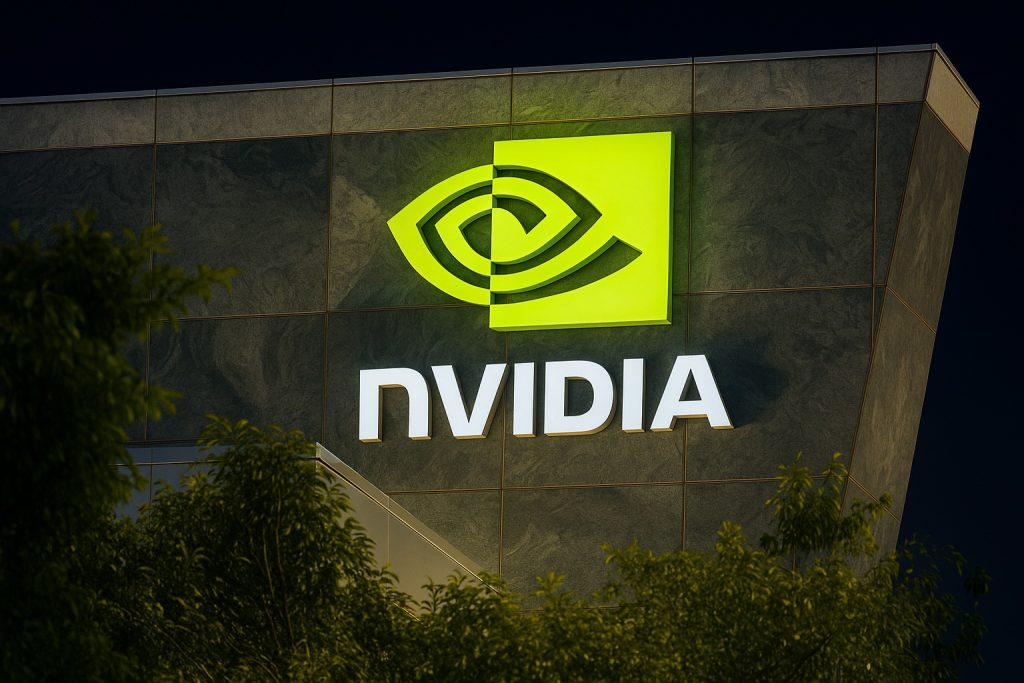- High-Stakes Earnings Week: Palantir and AMD headline a crucial week for markets, with tech giants, pharmaceutical firms, and others reporting Q3 results. Tech firms are expected to command the spotlight as market watchers zero in on artificial intelligence (AI) demand, especially with chipmakers (AMD, Qualcomm, Arm) and AI software leader Palantir reporting [1]. This focus is amplified by a U.S. government shutdown delaying key economic reports – investors must rely on corporate earnings and private data (like the ADP jobs report) to gauge the economy [2].
- Palantir’s Anticipated Surge: Palantir Technologies (PLTR) reports on Nov. 3, and analysts expect a blockbuster quarter – about 50% revenue growth (to ~$1.09 billion) and 70% higher earnings (around $0.17 per share) year-over-year [3]. The data-analytics firm has seen booming demand from both government and commercial clients for its AI platforms, fueling rapid growth. Palantir’s stock has more than doubled in 2025 (up roughly 145% year-to-date) amid the AI investment frenzy [4] [5], and it’s approaching all-time highs ahead of its earnings release.
- AMD Riding the AI Chip Wave: Advanced Micro Devices (AMD) reports on Nov. 4, with Wall Street forecasting about 28% revenue growth to $8.76 billion and 27% EPS growth to $1.17 [6] [7]. AMD’s stock has surged over 110% in 2025 on optimism around its data-center chips and high-profile partnerships in AI. Notably, AMD struck major deals with OpenAI and Oracle this year, signaling strong demand from top AI players for its GPUs and server chips [8]. These tailwinds have investors hoping for a big “beat-and-raise” quarter from AMD’s results.
- Analyst Views – Sky-High Targets vs. Rich Valuations: Despite the hype, experts are split on these AI darlings. Bank of America recently hiked Palantir’s price target to a Street-high $215 (from $180) and reiterated a Buy rating, citing accelerating commercial growth, expanding government contracts, and rising adoption of its Agentic AI systems as key drivers [9]. However, the average analyst 12-month target for Palantir is only about $158, and the stock’s premium valuation – roughly 409× forward earnings – has many warning that there is little room for error if growth falters [10] [11]. Palantir carries an extremely rich price tag even by tech standards.
- AMD Optimism… with Caution: Chipmaker AMD is also drawing bullish calls. Susquehanna’s Christopher Rolland recently upped his AMD target to $300 (from $210) with a Positive rating, expecting stronger data-center and PC chip demand in Q3 [12]. Rosenblatt Securities analyst Kevin Cassidy likewise maintained a Buy and a $250 target, predicting a “modest beat-and-raise quarter” for AMD driven by market-share gains in PC and server processors [13]. Yet here too valuation looms large – at about 41× 2026 earnings, AMD is an “incredibly expensive” stock, one analyst noted [14]. If the company can’t back up the recent AI-fueled hype with actual sales and big new orders, its shares could quickly stumble [15].
- Beyond Tech – Pharma and Gig Economy in Focus: It’s not just AI tech on the docket. Pharmaceutical giants like Novo Nordisk, Pfizer, Amgen, and AstraZeneca report this week amid intense political pressure to cut drug prices. In fact, Novo Nordisk (maker of Ozempic) faces public demands from President Trump to slash the cost of its popular weight-loss treatment from over $1,000 to about $150 per month [16]. Drug makers have even struck recent deals to lower prices to stave off threatened pharmaceutical tariffs [17]. Meanwhile, gig-economy leaders including Uber, DoorDash, and Airbnb will also announce earnings [18], providing a read on consumer spending trends. In sum, it’s a pivotal week spanning multiple sectors – and any surprises (good or bad) could sway the broader market.
AI-Driven Earnings Take Center Stage
After a turbulent October, investors are laser-focused on earnings results to close out the year – especially from companies at the heart of the 2025 AI boom. This week’s calendar is packed with high-profile names, and tech firms will likely command the spotlight. Advanced Micro Devices, Qualcomm, Arm Holdings, and Palantir – all tied to the artificial intelligence surge – are set to report quarterly results [19]. The market’s obsession with AI means traders will be parsing these reports for any signs of accelerating demand (or weakness) in semiconductors and AI software. Pharmaceuticals and other sectors will share the stage, but the AI theme is top of mind on Wall Street [20].
Several factors heighten the stakes. The ongoing U.S. government shutdown has put many economic reports on hold, depriving investors of some usual data points. For example, the Labor Department’s October jobs report – originally due Friday – is likely delayed, so the private-sector ADP employment report on Wednesday will carry extra weight [21]. Essentially, with Washington’s data pipeline frozen, corporate earnings are the market’s key source of insight into economic momentum. At the same time, the Federal Reserve injected some optimism by cutting interest rates last week for the second time this year [22]. Lower rates generally boost growth stocks, and indeed the stock market notched gains at the end of October after strong Big Tech earnings [23]. This creates an interesting backdrop: if this week’s earnings live up to the hype, they could reinforce the market rally. But any disappointment from an AI high-flyer might spark volatility given how much optimism is already priced in.
In short, the stage is set for a potential market-moving week. With official economic signals dimmed by the shutdown and a recent Fed rate cut easing financial conditions, investors will be eagerly watching these earnings. A handful of companies could swing market sentiment – none more so than Palantir and AMD, two emblematic winners of this year’s tech frenzy.
Palantir: Soaring Demand – and Sky-High Expectations
Palantir Technologies, a data analytics and software firm, has become a poster child of the AI-driven stock rally. The company reports its third-quarter earnings on Monday (Nov. 3) after the market close [24], and anticipation is running high. Wall Street expects blowout growth: consensus estimates call for earnings of around $0.17 per share (up 70% year-over-year) on revenue of roughly $1.09 billion (up about 50% YoY) [25]. If achieved, those figures would mark an acceleration from Q2 and underscore that demand for Palantir’s AI platforms remains red-hot.
Palantir’s recent performance has certainly been impressive. In Q2 2025, the company posted its first-ever $1 billion+ quarter, with revenue rising 48% year-over-year [26]. Both of Palantir’s main segments contributed roughly equally to that surge – commercial revenue jumped 47% YoY and government revenue climbed 49% YoY in Q2 [27]. Notably, U.S. commercial sales skyrocketed 93% last quarter [28], helped by new contracts in the booming AI arms race. Unlike many high-growth software firms, Palantir is already profitable; it recorded a healthy 33% profit margin in Q2 [29]. This combination of rapid growth and solid profitability has bolstered the bull case that Palantir is emerging as a dominant AI software provider.
Investors have certainly taken notice. Palantir’s stock has more than doubled in 2025, rising about 140–150% year-to-date [30] [31]. The share price is again flirting with all-time highs around the $190–$200 level [32]. This meteoric rise has been fueled by optimism around Palantir’s AI offerings – from its government defense platforms to its commercial AI toolkits – and a string of big contract wins. For instance, the company’s technology underpins major government projects; NATO selected Palantir’s “Maven Smart System” for battlefield intelligence earlier this year, and the U.S. Army and other agencies have awarded Palantir multi-hundred-million-dollar deals [33] [34]. “Palantir’s Field Deployment Engineers are now ‘deepening [the] use of Agentic AI’ to scale its platforms,” observed BofA Securities analyst Mariana Perez Mora in September, highlighting the company’s edge in applied AI at scale [35]. In short, Palantir has a track record of translating AI hype into tangible revenue – and investors expect more of the same this quarter.
All this success, however, means expectations are sky-high, and Palantir’s valuation has grown very demanding. The stock’s massive rally has stretched its trading multiples into uncharted territory. Palantir recently traded around 132 times trailing sales and over 200 times its projected 2026 earnings – levels almost unheard of for a company growing ~50% rather than triple-digits [36]. In fact, at current prices Palantir is about 409× forward earnings, a “premium valuation” that leaves little room for error if the company’s growth slows [37]. Even bullish analysts acknowledge the stock isn’t cheap. Bank of America’s Perez Mora – arguably Palantir’s biggest Wall Street cheerleader – argues the premium is justified by Palantir’s unique position in AI. She points to Palantir’s accelerating commercial growth, expanding roster of government contracts, and the rising adoption of its AI systems in the field as reasons the company can sustain high growth for years [38] [39]. BofA’s confidence is reflected in its $215 price target, which is currently the highest on the Street [40]. If Palantir delivers another upbeat quarter and raises its outlook, bulls believe the stock can continue to defy gravity.
However, many other experts urge caution. The consensus view among analysts is only a “Hold” on Palantir shares [41]. Out of 19 analysts tracked, just 4 rate it a Buy, while the majority recommend holding and a couple even say Sell [42]. HSBC, for example, raised its target price to $181 back in August (after Q2 results) but maintained a Hold rating, citing execution risks and valuation pressure at Palantir’s lofty price [43]. The average 12-month price target is around $158, which actually implies modest downside from recent trading levels [44]. In other words, the professional analyst community largely believes Palantir’s stock has run ahead of its fundamentals. They’ll be watching Q3’s numbers – and the company’s guidance – closely to see if Palantir can justify its enormous market capitalization (around $440 billion [45]) or if some of the enthusiasm is overblown.
For investors, Monday’s earnings report will be a pivotal moment. If Palantir beats expectations handily (as it has in the past) and issues bullish guidance, it could reignite the rally and silence some doubters. Palantir’s management has developed a reputation for outperforming the targets it sets. In fact, one stock analyst noted that “management has a strong track record of outperforming expectations it lays out, so another earnings beat seems likely on Nov. 3”, which could send the stock higher again [46]. On the flip side, if results merely meet forecasts or guidance disappoints, a richly valued stock like Palantir could see a sharp pullback. Priced for perfection, any hiccup in its growth story or AI traction might prompt investors to take profits. Thus, Palantir’s earnings are a high-stakes affair – not just for Palantir shareholders but potentially for sentiment around all the AI-focused stocks that have soared alongside it.
AMD: Big AI Chip Bets Face a Reality Check
Just a day after Palantir, attention will shift to Advanced Micro Devices (AMD) – another major player riding the AI wave. AMD will announce its Q3 results on Tuesday, Nov. 4 (after the closing bell) [47]. Like Palantir, AMD has enjoyed a huge stock surge in 2025: shares have climbed approximately 112% year-to-date [48], more than doubling on optimism that this chipmaker can challenge Nvidia’s dominance in AI processors. The stakes are high for AMD’s earnings, which could either validate the bullish narrative or raise new questions about how far the AI chip boom can carry it.
Wall Street’s baseline expectation is that AMD will show solid growth but not a dramatic explosion (yet). Consensus estimates peg Q3 revenue around $8.75–$8.8 billion, which would be about 28% higher than a year ago [49] and mark an all-time quarterly revenue record for AMD [50]. Earnings per share are forecast at roughly $1.17, up ~27% year-on-year [51] [52]. These are impressive numbers in most contexts – they handily outpace the broader semiconductor industry’s growth – but they also indicate that AMD hasn’t yet seen the kind of exponential jump that Nvidia experienced earlier this year from AI demand. For comparison, Nvidia’s data-center revenue doubled year-over-year in its last report, reflecting insatiable demand for its AI accelerators. AMD is hoping to close that gap in coming quarters.
There are encouraging signs for AMD. The company’s traditional businesses (PC, gaming, and console chips) have stabilized, and its data center segment is driving growth. CEO Lisa Su has been investing heavily in AI-centric products – most notably the MI300 series GPU accelerators meant to compete with Nvidia’s flagship AI chips. Recent partnerships have given AMD’s AI ambitions a credibility boost. In October, AMD announced a landmark deal with OpenAI, the leading AI research firm (creator of ChatGPT). AMD agreed to provide up to 6 gigawatts of cloud GPU capacity to OpenAI, and in return OpenAI is reportedly helping AMD improve its software ecosystem [53] [54]. This partnership was a “big deal” because it signaled that a top-tier AI player will use AMD’s hardware, whereas previously Nvidia was seen as the only real option [55]. Around the same time, AMD also revealed a major win with Oracle – supplying AI chips for Oracle’s cloud services [56]. These deals suggest that AMD’s AI chips are gaining traction with marquee customers, which could translate into a swelling order pipeline going forward.
However, AMD still has a lot to prove, and investors know it. The company’s last earnings left some questions. In Q2 2025, AMD’s data center revenue rose only 14% year-over-year (and actually declined sequentially) [57] – a far cry from Nvidia’s blistering 56% data center growth in the same timeframe [58]. AMD’s management attributed some of the weakness to customers delaying purchases ahead of its new product launches. The real impact of the OpenAI deal (announced in October) won’t show up until future quarters, so Q3’s results may not fully reflect the recent buzz [59]. What investors will listen for closely is AMD’s guidance and commentary on future AI chip demand. If CEO Lisa Su and her team talk up a large backlog of orders or “unprecedented demand” heading into 2024, that could be the catalyst to send AMD’s stock higher again. Conversely, if the outlook is only modest or management sounds cautious about how fast AI revenue will ramp, the market could react negatively – because a lot of hype is already baked into AMD’s stock price.
Indeed, like Palantir, AMD’s valuation has ballooned alongside its stock surge. AMD trades around 40× forward earnings and roughly 9× sales, rich even for a high-growth semiconductor firm [60]. As one analyst bluntly put it, “At 41 times 2026 earnings, AMD is an incredibly expensive stock,” and it’s a “huge risk” if the company cannot convert its positive AI news into actual sales growth [61]. In other words, AMD’s current stock price assumes that the company will successfully grab a big piece of the booming AI chip market. If that thesis is undermined – say, by evidence that Nvidia or others are still capturing the lion’s share of new orders – AMD could be in for a reality check. The upside is that any concrete signs of AMD closing the gap with Nvidia could ignite another rally. Should AMD announce, for example, a few multibillion-dollar cloud contracts or a much better-than-expected forecast for next quarter, investors would likely take it as confirmation that AMD can ride the AI wave and perhaps eventually approach Nvidia’s level of success. As the Motley Fool’s tech analysts noted, AMD’s stock could “soar” on the earnings news if massive new AI deals are unveiled – but the opposite is also true if results disappoint, given the premium valuation [62].
Wall Street analysts are generally optimistic for this quarter. Beyond the bullish calls from Susquehanna and Rosenblatt (who expect a beat and have set price targets of $300 and $250 respectively) [63] [64], we’ve seen positive sentiment from other quarters. Even AI models are bullish on AMD – TipRanks’ GPT-4 based “AI Analyst” recently raised its hypothetical price target for AMD to $295, citing strong financial momentum and technical stock trends [65]. Of course, not everyone is convinced; some analysts recommend waiting to see concrete results before piling into AMD stock. The bottom line for AMD is that this earnings report is a critical test of whether its AI strategy is truly paying off. It comes at a time when rival chipmakers are also in the spotlight – Qualcomm, for instance, is reporting this week and just unveiled new AI chips for data centers [66], and Nvidia’s own next earnings are only a few weeks away. AMD will want to show that it can capture AI demand, not just ride PC market cycles. If it can deliver a “beat-and-raise” quarter (exceeding Q3 estimates and guiding higher for Q4), it will reinforce the narrative that AMD is the clear No. 2 contender in the AI chip race. If not, the stock may face a painful re-rating.
Market Outlook: AI Hype Meets Reality
As Palantir, AMD, and their peers report, the broader market will be taking cues from these results. These companies are bellwethers for different facets of the tech sector’s 2025 rally – Palantir for AI software and data analytics, AMD for AI hardware and chips. Both stocks have ridden a wave of exuberance, so their earnings will help answer the pressing question: Is the AI boom living up to the hype? A string of strong reports could extend the tech stock rally that has powered markets in recent weeks (the S&P 500 just logged weekly and monthly gains, aided by big tech earnings beats) [67]. On the other hand, any stumble by a high-profile name could inject volatility, given how crowded some of these trades have become.
Investors should keep a few things in mind as the week unfolds. First, macro-economic context is muted but still relevant. The lack of a federal jobs report (due to the government shutdown) means markets will lean even more on earnings and alternative data [68]. For instance, a strong ADP private jobs number on Wednesday could boost confidence, but a miss might raise concerns – potentially affecting how earnings results are received. Additionally, with the Fed having just cut interest rates, monetary policy is turning slightly more supportive for stocks [69]. Lower rates can justify higher stock valuations, especially for growth companies, so the Fed’s dovish tilt might cushion any minor earnings misses. However, it’s a double-edged sword: the Fed is cutting rates partly due to economic headwinds (and a prolonged government shutdown), so investors are also alert to any signs of a broader slowdown that could hit corporate profits.
In the end, the narrative around AI stocks will crystallize around actual performance versus expectations. Companies like Palantir and AMD have set a high bar – both in terms of investor expectations and stock price multiples. To keep climbing, they need to consistently deliver high growth (or even accelerating growth) and prove that their AI initiatives can turn into sustained profits. The risk for these stocks is that even good results might not be “good enough” if the market expected spectacular results. As one analyst warned about AMD, much hype has built up “for relatively little financial success” so far [70] – meaning these firms must convert story into substance. Conversely, the opportunity is that truly blowout earnings or bullish outlooks could reignite another leg of the rally, not just for these companies but for tech stocks broadly.
For the public and investors at large, this week offers a reality check on some of 2025’s hottest stocks. Palantir’s and AMD’s earnings will signal whether the AI revolution on Wall Street is backed by real-world gains or whether valuations have sprinted ahead of fundamentals. If both companies smash expectations – say Palantir comfortably exceeding that ~50% growth target, or AMD unveiling huge new AI chip orders – it would reinforce that we are in an AI-driven upcycle with more room to run. That could lift market sentiment across the board. But if results show any cracks, we may see a swift re-pricing of risk. The fact that Palantir and AMD trade at 100+ P/E ratios and other eye-popping multiples means even a small disappointment can trigger an outsized reaction as investors recalibrate their outlook.
In summary, the coming days will be a critical test of AI hype versus reality. Palantir and AMD, alongside other notable reporters like Qualcomm, Pfizer, Novo Nordisk, Uber, and more, will set the tone. All eyes are on whether these “AI winners” can keep delivering. A week from now, we’ll know if the AI stock boom is getting another boost of validation – or if November brought a dose of sobriety to exuberant markets. As always, savvy investors will be watching the numbers and guidance closely, ready to respond to what the real-world data says about these high-flying companies [71].
Sources:
- Investopedia – What To Expect in Markets This Week: AMD, Palantir, Pharmaceutical and Tech Earnings [72] [73] [74]
- Nasdaq (Zacks) – Palantir Gears Up to Report Q3 Earnings: Here’s What You Should Know [75]
- Nasdaq (Motley Fool) – Should You Buy Palantir Stock Before Nov. 3? [76] [77] [78]
- TipRanks – Here’s Why 5-Star BofA Analyst Thinks the Palantir Stock Forecast Should Be $215 [79] [80] [81]
- TipRanks – Advanced Micro Devices (AMD) Q3 2025 Earnings – What to Expect [82] [83] [84]
- Nasdaq (Motley Fool) – Prediction: AMD’s Stock Could Soar on Nov. 4 [85] [86]
- Investopedia – Markets News, Nov. 2, 2025 [87] (market recap after tech earnings)
References
1. www.investopedia.com, 2. www.investopedia.com, 3. www.nasdaq.com, 4. www.investopedia.com, 5. www.tipranks.com, 6. www.tipranks.com, 7. www.tipranks.com, 8. www.tipranks.com, 9. www.tipranks.com, 10. www.tipranks.com, 11. www.tipranks.com, 12. www.tipranks.com, 13. www.tipranks.com, 14. www.nasdaq.com, 15. www.nasdaq.com, 16. www.investopedia.com, 17. www.investopedia.com, 18. www.investopedia.com, 19. www.investopedia.com, 20. www.investopedia.com, 21. www.investopedia.com, 22. www.investopedia.com, 23. www.investopedia.com, 24. www.nasdaq.com, 25. www.nasdaq.com, 26. www.tipranks.com, 27. www.nasdaq.com, 28. www.tipranks.com, 29. www.nasdaq.com, 30. www.nasdaq.com, 31. www.investopedia.com, 32. www.tipranks.com, 33. www.tipranks.com, 34. www.tipranks.com, 35. www.tipranks.com, 36. www.nasdaq.com, 37. www.tipranks.com, 38. www.tipranks.com, 39. www.tipranks.com, 40. www.tipranks.com, 41. www.tipranks.com, 42. www.tipranks.com, 43. www.tipranks.com, 44. www.tipranks.com, 45. www.tipranks.com, 46. www.nasdaq.com, 47. www.tipranks.com, 48. www.tipranks.com, 49. www.tipranks.com, 50. seekingalpha.com, 51. www.tipranks.com, 52. www.tipranks.com, 53. www.nasdaq.com, 54. www.nasdaq.com, 55. www.nasdaq.com, 56. www.tipranks.com, 57. www.nasdaq.com, 58. www.nasdaq.com, 59. www.nasdaq.com, 60. www.nasdaq.com, 61. www.nasdaq.com, 62. www.nasdaq.com, 63. www.tipranks.com, 64. www.tipranks.com, 65. www.tipranks.com, 66. www.investopedia.com, 67. www.investopedia.com, 68. www.investopedia.com, 69. www.investopedia.com, 70. www.nasdaq.com, 71. www.nasdaq.com, 72. www.investopedia.com, 73. www.investopedia.com, 74. www.investopedia.com, 75. www.nasdaq.com, 76. www.nasdaq.com, 77. www.nasdaq.com, 78. www.nasdaq.com, 79. www.tipranks.com, 80. www.tipranks.com, 81. www.tipranks.com, 82. www.tipranks.com, 83. www.tipranks.com, 84. www.tipranks.com, 85. www.nasdaq.com, 86. www.nasdaq.com, 87. www.investopedia.com







